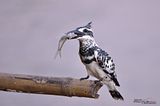Have you ever wondered how this smart looking wader got its name? I thought about it a lot, along with other names like Dunlin and Godwit as well, so I did a little bit of research through Google and came across this very interesting explanation. The website is called Bird Watcher's General Store. It contains short articles written by American birder Mike O'Connor originally published in the column called Ask the Bird Folks in The Cape Codder newspaper. Every week he answers a question about birds submitted by readers. I had a great fun going through many of his articles. He answered all the questions in a very humorous way, trying to make people become more interested in birds by connecting them to ordinary issues in our lives. He really did make birding sounds fun!
 Whimbrel (Numenius phaeopus variegatus)
Whimbrel (Numenius phaeopus variegatus)




So it turns out that the name of the bird didn't come from any particularly interesting reason. It simply came from the bird's high-pitched and whimpering voice. I was a little disappointed. I expected a little more historical and mythical explanation. Anyway, these photos of Whimbrels were taken back in September 23 at Shouninga-hama beach. I was happy to see a small number of these birds walking on the beach below the walk way. It's never easy to get close to Whimbrels as they are normally shy, so I had to lie down on the ground hiding myself behind the low fence and waited for the birds to come my way. The outcome is as you see. I can truly say that these are my best shots of Whimbrels.



This one was in a much shaggier plumage





Here's what I love about Whimbrels (apart from their very unusual name); their beautiful bluish legs. There are already redshanks, greenshanks and yellowlegs, so why not calling them blueshank or bluelegs. I heard that some people call avocets blueshank, but come on they're not sandpipers. I also took a few handheld videos of one of the birds that was bathing right in front of me, but I still haven't got the time to process them. I'll put them up later. Here's the bathing set of photos for now. Enjoy! Oh and by the way, you can clearly see its completely barred rump, a characteristic of the subspecies N.p. variegatus of East Asia.
















.jpg)

4 comments:
Great Whimbrel shots.
So what does Godwit mean then?!?!
Great series of photographs. Lots of great poses and the colours are superb. I have a handful of so-so pics from Australia....just not close enough. You did very well.
Thanks Stu and Russell!
Here's what I found from Wikipedia
"The name Godwit originates in Old English with god meaning good, and wit coming from wihte, meaning creature."
So..."good creature"? lol
Just great pictures of a species that as you say is almost impossible to get close to.
Post a Comment